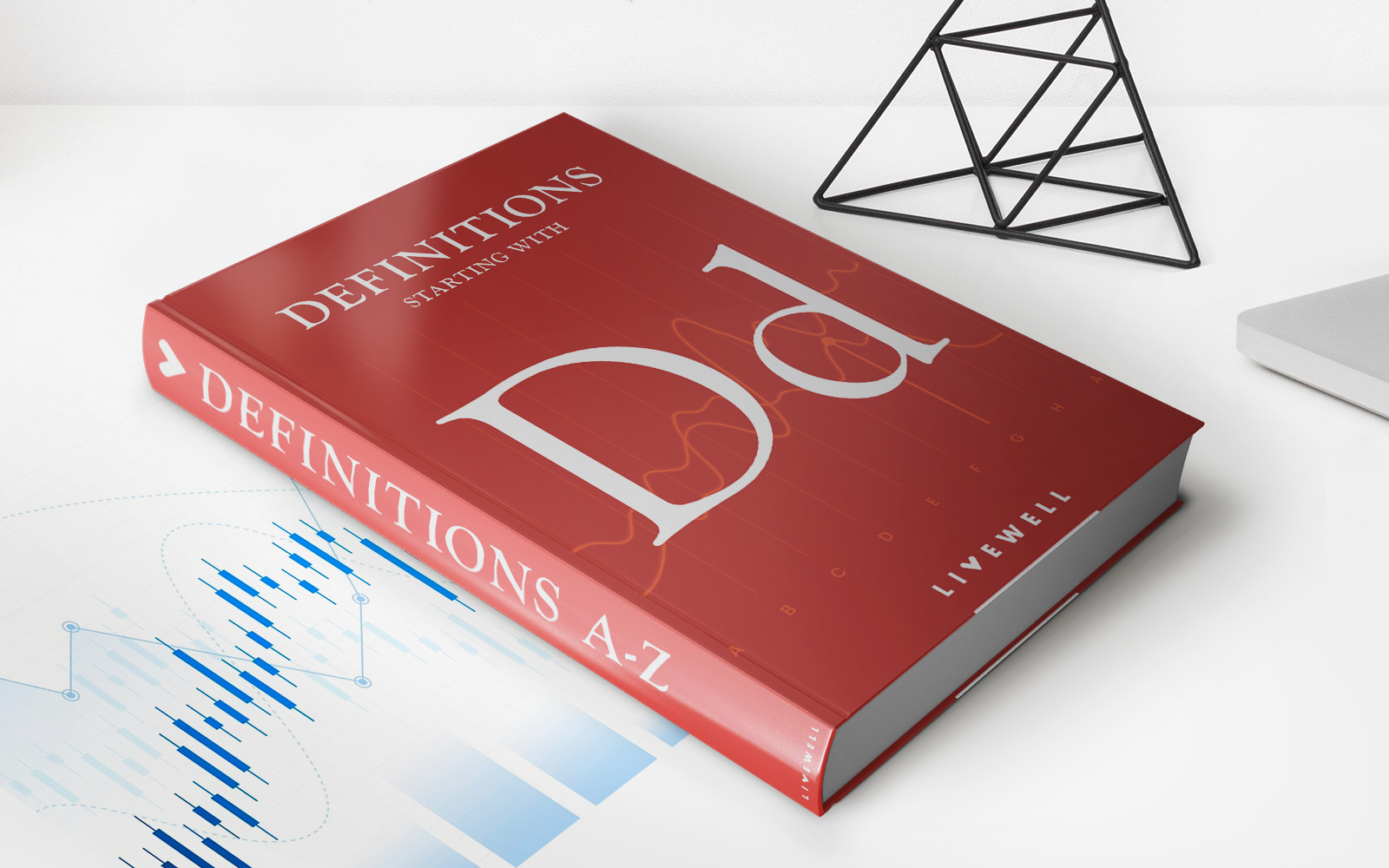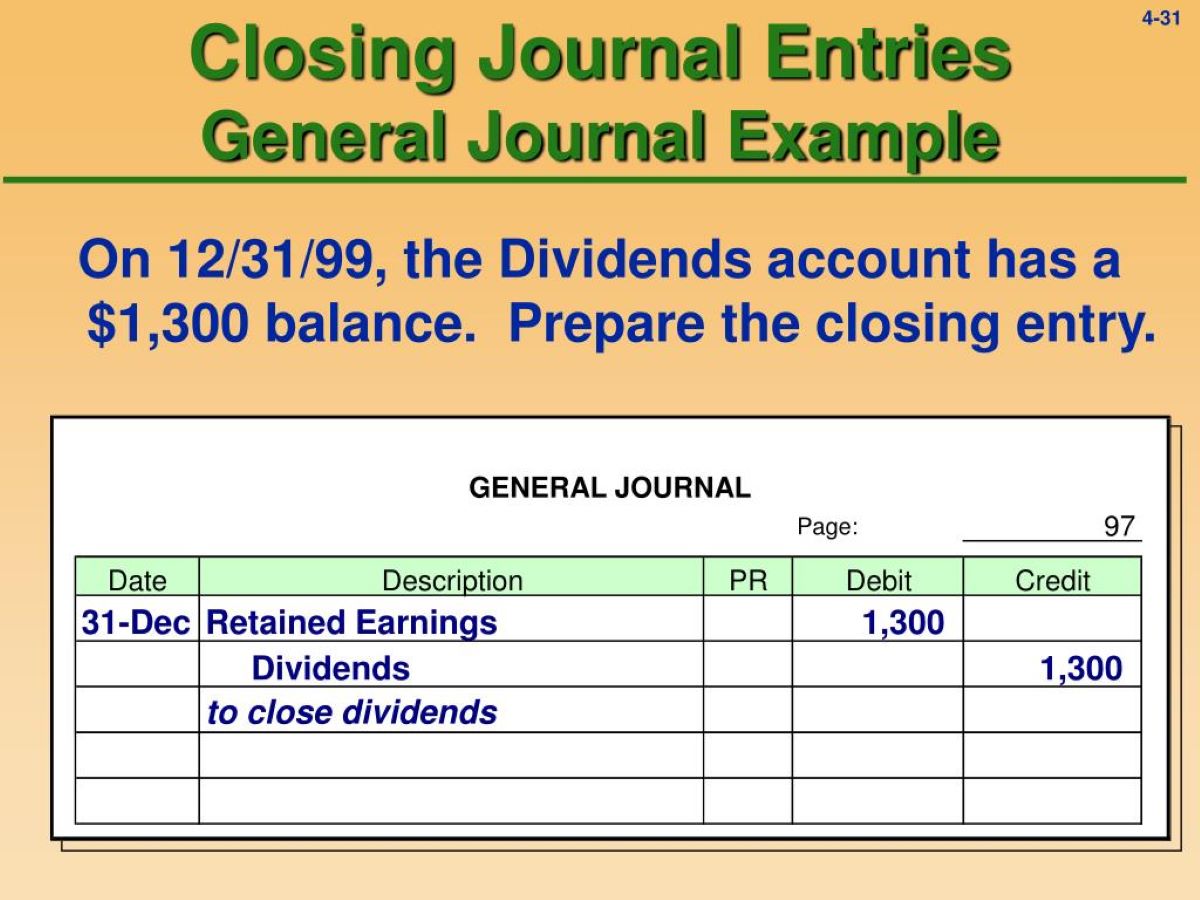Home>Finance>What Accounts Are Closed At The End Of The Accounting Period


Finance
What Accounts Are Closed At The End Of The Accounting Period
Modified: December 30, 2023
Learn about the closed accounts in finance at the end of an accounting period. Discover how this process impacts your financial statements and overall business performance.
(Many of the links in this article redirect to a specific reviewed product. Your purchase of these products through affiliate links helps to generate commission for LiveWell, at no extra cost. Learn more)
Table of Contents
Introduction
In the world of finance and accounting, it’s essential to keep track of transactions and ensure accurate and up-to-date records. One crucial aspect of this process is closing accounts at the end of the accounting period. This practice allows businesses to organize their financial information and prepare for the next period.
The concept of closing accounts refers to the process of transferring the balances of certain accounts to a temporary account, often known as the income summary account or retained earnings account. By doing so, businesses can calculate their net income or loss for the period and accurately reflect the financial position at the end of the period.
While the specific accounts closed may vary depending on the nature of the business and its accounting system, there are some common types of accounts that are typically closed at the end of the accounting period. These include revenue accounts, expense accounts, and dividend accounts.
Understanding the accounts that are closed at the end of the accounting period is crucial for financial professionals, business owners, and investors. In this article, we will dive into the details of each type of account that is closed, why they are closed, and the impact this process has on financial statements and decision-making.
Definition of Accounting Period
Before delving into the specifics of closing accounts at the end of the accounting period, it’s important to understand what an accounting period is. An accounting period refers to a specific timeframe in which a company’s financial activities and transactions are recorded, summarized, and reported.
The duration of an accounting period can vary. Common timeframes include a month, a quarter (three months), or a year. The choice of the accounting period depends on the business’s needs, industry standards, and legal requirements.
During the accounting period, businesses record various financial transactions, such as sales, expenses, investments, and loan repayments. These transactions are then organized into different accounts, reflecting the specific nature of each transaction. Examples of accounts include revenue accounts, expense accounts, asset accounts, liability accounts, and equity accounts.
It’s important to note that the closing of accounts at the end of the accounting period does not mean that the accounts are permanently closed or discontinued. Instead, it refers to the process of transferring the balances of certain accounts to a temporary account in order to calculate the net income or loss for the period.
The closing of accounts paves the way for the start of a new accounting period and allows businesses to maintain accurate and updated financial records. It is a fundamental concept in financial reporting and ensures that financial statements reflect the company’s financial position at a specific point in time.
Overall, the accounting period serves as a crucial time frame for tracking financial activities, analyzing performance, making informed decisions, and meeting regulatory requirements. The closure of accounts at the end of this period is an essential step in the accounting cycle and prepares businesses for the next phase of financial reporting and analysis.
Purpose of Closing Accounts at the End of the Accounting Period
The closing of accounts at the end of the accounting period may seem like a technical process, but it serves several important purposes for businesses. Let’s explore the key reasons why accounts are closed at the end of the accounting period:
1. Calculating Net Income or Loss: By closing revenue and expense accounts, businesses can determine their net income or loss for the accounting period. Revenue accounts represent income generated from sales, services, or investments, while expense accounts reflect the costs incurred to operate the business. Closing these accounts allows for the calculation of the overall profitability or loss incurred during the period.
2. Preparing Financial Statements: Closing accounts is a critical step in the preparation of financial statements, such as the income statement and balance sheet. By transferring the balances of revenue and expense accounts to the income summary account, businesses can accurately present revenue, expenses, and net income on their income statements. Additionally, closing dividend accounts ensures the proper disclosure of dividends paid to shareholders on the statement of retained earnings.
3. Maintaining Accurate Financial Records: The closure of accounts ensures that financial records are organized and up to date. By summarizing the revenue, expenses, and dividend activities of the accounting period, businesses can have a clear understanding of their financial position. This accuracy is essential for internal decision-making, external reporting, and compliance purposes.
4. Tracking Performance and Analyzing Trends: Closing accounts at the end of the accounting period allows businesses to assess their financial performance over time. By comparing net income or loss from period to period, organizations can identify growth patterns, profitability trends, and areas for improvement. This information is vital for strategic decision-making, budgeting, and forecasting future financial outcomes.
5. Facilitating Audit and Financial Analysis: Properly closed accounts provide a transparent and reliable basis for audits and financial analysis. Auditors can review the closing process to ensure adherence to accounting standards and to confirm the accuracy of financial statements. Investors, creditors, and other stakeholders rely on accurate financial information to evaluate the financial health and performance of a business.
Overall, closing accounts at the end of the accounting period is a crucial step in the financial management process. It not only allows businesses to calculate net income, prepare financial statements, and maintain accurate records but also enables them to assess performance, make informed decisions, and fulfill regulatory obligations.
Types of Accounts that are Closed
When it comes to closing accounts at the end of the accounting period, there are several types of accounts that businesses typically close to ensure accurate financial reporting. These accounts include revenue accounts, expense accounts, and dividend accounts. Let’s take a closer look at each of these types:
1. Revenue Accounts: Revenue accounts represent the income generated by a business from its primary operations, such as sales of products or services. Examples include sales revenue, service revenue, interest income, and rental income. At the end of the accounting period, revenue accounts are closed by transferring their balances to the income summary account. This calculation allows businesses to determine their total revenue for the period.
2. Expense Accounts: Expense accounts, on the other hand, record the costs incurred in running a business. These costs encompass various expenditures, such as rent, utilities, salaries, marketing expenses, and supplies. Similar to revenue accounts, expense accounts are closed at the end of the accounting period by transferring their balances to the income summary account. This process allows businesses to determine their total expenses for the period.
3. Dividend Accounts: Dividend accounts are specific to companies that distribute earnings to shareholders in the form of dividends. Dividends are typically paid out of retained earnings and represent a portion of the company’s profits. At the end of the accounting period, dividend accounts are closed by transferring their balances to the retained earnings account. This ensures that the dividends paid out are properly reflected in the company’s financial statements.
It’s important to note that not all types of accounts are closed at the end of the accounting period. Accounts such as asset accounts, liability accounts, and equity accounts are not closed because they represent ongoing balances that carry over from one period to the next. These accounts are typically reported on the balance sheet as of the end of the accounting period, providing a snapshot of the company’s financial position.
By closing revenue, expense, and dividend accounts, businesses can accurately calculate their net income or loss for the accounting period. This information is crucial for financial reporting, decision-making, and assessing the overall performance and profitability of the business. The closure of these accounts also sets the stage for the start of a new accounting period, providing a clean slate for tracking future transactions.
Revenue Accounts
Revenue accounts are a vital component of a company’s financial records as they track the income generated from its core operations. These accounts represent the inflow of resources resulting from the sale of goods, provision of services, or other revenue-earning activities. Examples of revenue accounts include sales revenue, service revenue, interest income, and rental income.
At the end of the accounting period, revenue accounts are closed to determine the total revenue earned during that period. The process of closing these accounts involves transferring their balances to the income summary account or directly to the retained earnings account.
The closure of revenue accounts serves several purposes:
1. Calculating Net Sales: By closing revenue accounts, businesses can calculate their net sales for the accounting period. Net sales represent the total revenue earned after deducting any sales returns, allowances, or discounts.
2. Evaluating Revenue Sources: Closing revenue accounts allows businesses to analyze the sources of their income. It provides insights into which products, services, or revenue streams are contributing the most to the company’s overall revenue.
3. Facilitating Comparative Analysis: By comparing revenue figures from different accounting periods, businesses can gain a better understanding of their growth patterns and revenue trends. This analysis assists in making informed decisions related to pricing, marketing strategies, and product/service offerings.
4. Preparing Financial Statements: Closing revenue accounts is crucial for the preparation of the income statement or profit and loss statement. The balances transferred to the income summary account are used to calculate the net income or loss for the accounting period.
It is important to note that revenue accounts are typically reopened at the beginning of each new accounting period. This allows businesses to record revenue for the upcoming period separately and track it separately from previous periods.
By closing revenue accounts at the end of the accounting period, businesses can accurately determine their net sales, analyze revenue sources, and prepare financial statements. This process not only provides valuable insights into the company’s financial performance but also sets the foundation for tracking revenue in the subsequent accounting period.
Expense Accounts
Expense accounts are an integral part of a company’s financial records as they track the costs incurred in operating the business. These accounts represent the outflow of resources to pay for various expenses such as rent, utilities, salaries, advertising, and office supplies.
At the end of the accounting period, expense accounts are closed to determine the total expenses incurred during that period. The closure process involves transferring the balances of these accounts to the income summary account or directly to the retained earnings account.
The closure of expense accounts serves several purposes:
1. Determining Total Expenses: By closing expense accounts, businesses can calculate the total expenses incurred during the accounting period. This information is crucial for assessing the overall costs of operations and determining the net income or loss.
2. Evaluating Cost Efficiency: Closing expense accounts allows businesses to analyze their expenditure patterns and identify areas where cost savings can be achieved. This assessment can lead to more effective budgeting and resource allocation in the future.
3. Preparing Financial Statements: The balances transferred from expense accounts to the income summary account are used to calculate the net income or loss on the income statement. This provides a clear picture of the financial performance for the accounting period.
4. Assessing Profitability: By comparing expense figures from different accounting periods, businesses can evaluate their profitability trends and make informed decisions about cost control and revenue generation strategies.
It is worth noting that like revenue accounts, expense accounts are typically reopened at the start of each new accounting period. This allows businesses to record expenses for the upcoming period separately and track them individually from previous periods.
Closing expense accounts at the end of the accounting period enables businesses to determine their total expenses, evaluate cost efficiency, and prepare accurate financial statements. This process is essential for measuring profitability, identifying areas of improvement, and making informed decisions regarding operations and financial management.
Dividend Accounts
Dividend accounts are specific to corporations that distribute a portion of their earnings to shareholders in the form of dividends. Dividends are typically paid out of the company’s retained earnings, which are accumulated profits that have not been distributed to shareholders in prior periods.
At the end of the accounting period, dividend accounts are closed to ensure accurate financial reporting. The closure process involves transferring the balances of dividend accounts to the retained earnings account. This ensures that the dividends paid out during the period are properly reflected in the company’s financial statements.
The closure of dividend accounts serves several purposes:
1. Reflecting Dividend Distributions: Closing dividend accounts allows businesses to accurately report the dividends paid to shareholders during the accounting period. This information is important for both internal and external stakeholders to understand the return on their investment in the company.
2. Maintaining Proper Recordkeeping: The closure of dividend accounts ensures that the distribution of dividends is properly documented. By transferring the balances to the retained earnings account, businesses maintain accurate records of dividend payments and their impact on the company’s financial position.
3. Providing Transparency to Shareholders: Closing dividend accounts promotes transparency by clearly showing how much of the company’s profits have been distributed to shareholders in the form of dividends. Shareholders can rely on this information to evaluate the company’s dividend policy and assess the returns they receive on their investment.
4. Aiding in Regulatory Compliance: Properly closing dividend accounts ensures compliance with accounting standards and regulations. Clear documentation of dividend distributions helps businesses fulfill their reporting obligations to regulatory bodies and provide accurate financial statements to stakeholders.
It’s important to note that dividend accounts are typically reopened in subsequent periods whenever the company declares and distributes dividends. This allows for the proper tracking and recording of future dividend payments.
By closing dividend accounts at the end of the accounting period, businesses ensure the accurate reporting and documentation of dividend distributions. This practice provides transparency to shareholders, aids in regulatory compliance, and allows for effective recordkeeping and financial analysis.
Summary of Accounts Closed at the End of the Accounting Period
Closing accounts at the end of the accounting period is a crucial step in the financial reporting process. It involves transferring the balances of certain accounts to temporary accounts, allowing businesses to calculate their net income or loss for the period and accurately reflect their financial position. Let’s summarize the types of accounts that are typically closed at the end of the accounting period:
1. Revenue Accounts: Revenue accounts, such as sales revenue, service revenue, and interest income, are closed to calculate the total revenue earned during the accounting period. The balances are transferred to the income summary account.
2. Expense Accounts: Expense accounts, which record costs such as rent, utilities, and salaries, are closed to determine the total expenses incurred during the period. The balances are transferred to the income summary account.
3. Dividend Accounts: Dividend accounts are closed to accurately reflect the dividends paid out to shareholders during the accounting period. The balances are transferred to the retained earnings account.
These closures serve several purposes. They allow businesses to calculate net income or loss, prepare financial statements, track performance, analyze trends, and make informed decisions. By closing these accounts, businesses can maintain accurate financial records, facilitate audits, and comply with regulatory requirements.
It’s important to note that not all types of accounts are closed at the end of the accounting period. Asset accounts, liability accounts, and equity accounts are typically carried forward and reported on the balance sheet as of the end of the period.
By understanding the accounts that are closed at the end of the accounting period, businesses can ensure their financial reports accurately reflect their operations and financial performance. This process sets the stage for the next accounting period and provides a solid foundation for financial planning, analysis, and decision-making.
Conclusion
Closing accounts at the end of the accounting period is an essential practice in financial management. It allows businesses to accurately calculate their net income or loss, prepare financial statements, and maintain transparent and reliable financial records. By closing revenue accounts, expense accounts, and dividend accounts, businesses can effectively track their income, expenses, and distributions at the end of each accounting period.
The closure of accounts serves several purposes, including determining total revenue, evaluating cost efficiency, reflecting dividend distributions, and providing transparency to shareholders. It aids in financial analysis, decision-making, and compliance with accounting standards and regulations. By closing these accounts, businesses can assess their financial performance, identify trends, and make informed decisions for future operations.
Furthermore, the closure of accounts sets the stage for the start of a new accounting period, allowing businesses to track transactions and financial activities separately from previous periods. This organized approach facilitates accurate financial reporting, comparative analysis, and strategic planning.
In conclusion, closing accounts at the end of the accounting period is a crucial part of the financial management process. It ensures accurate financial reporting, facilitates decision-making, and provides stakeholders with valuable insights into a company’s financial position and performance. By understanding the types of accounts that are closed and their significance, businesses can maintain reliable financial records, comply with regulatory requirements, and make informed decisions to drive success and growth.














